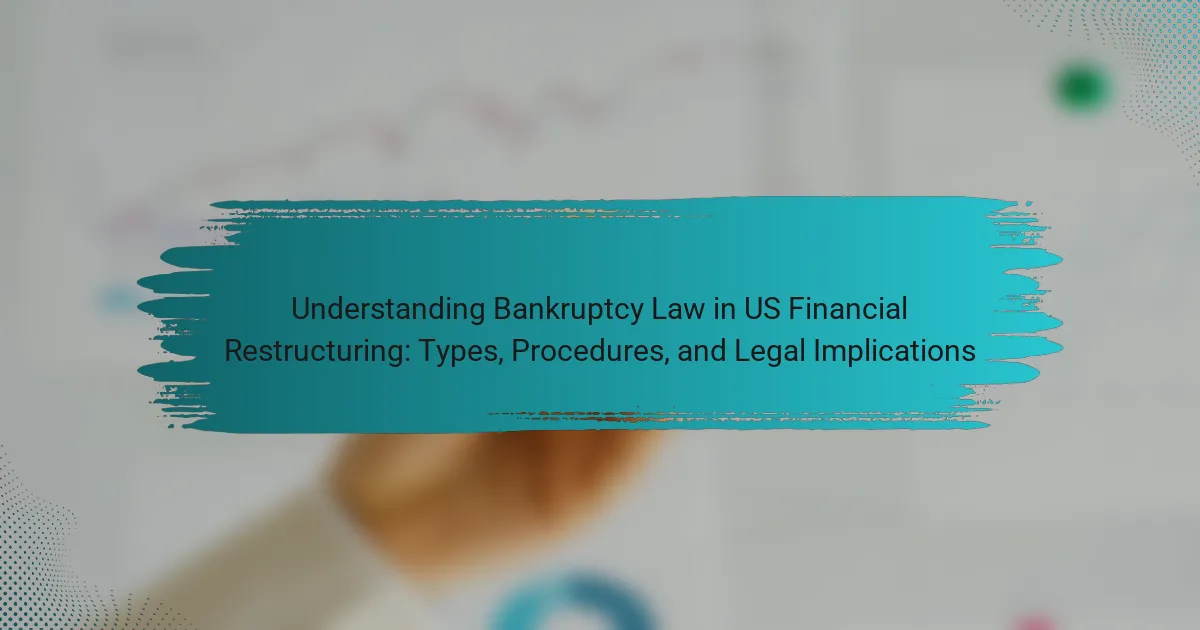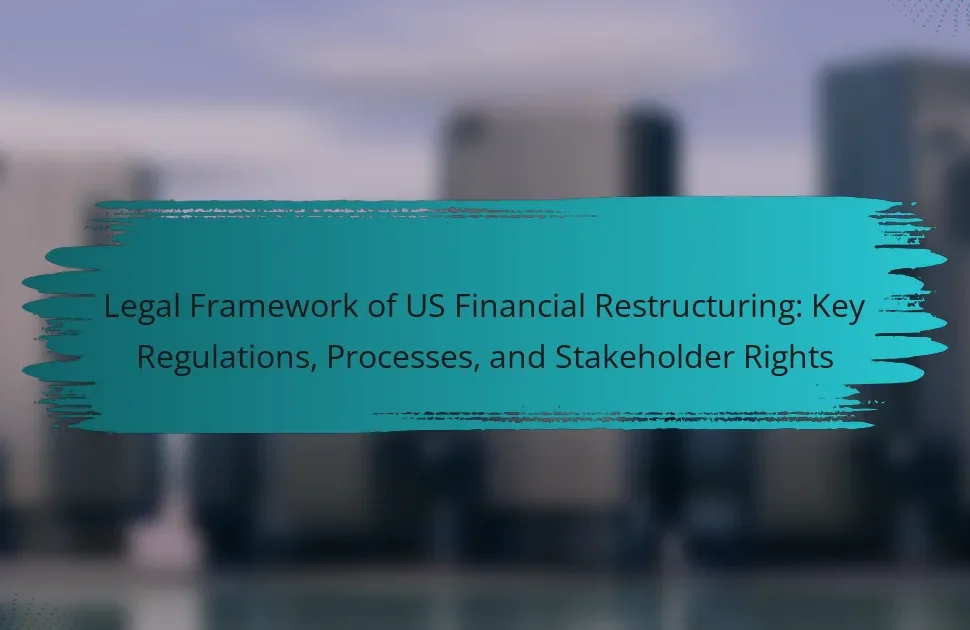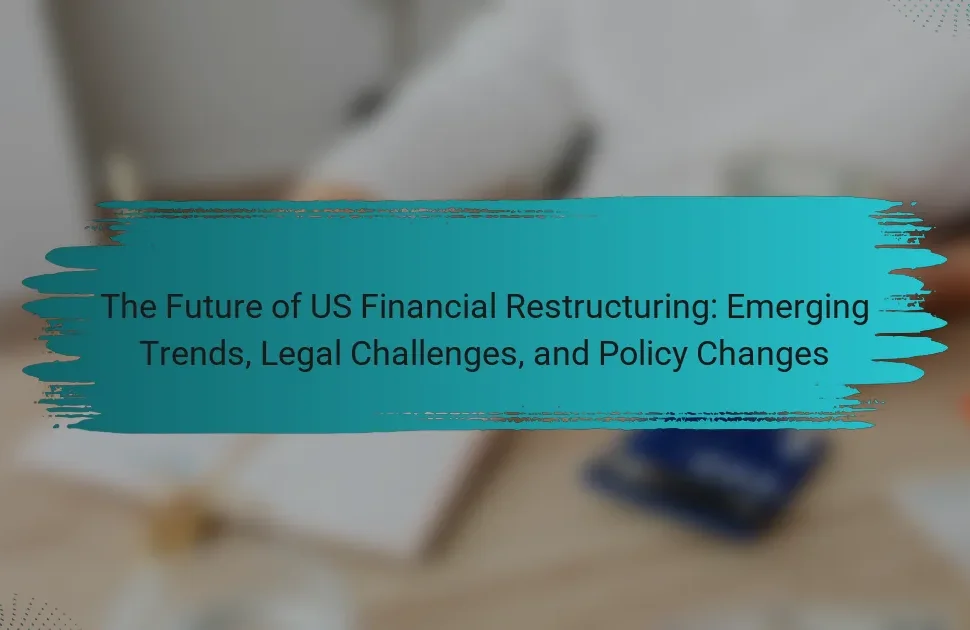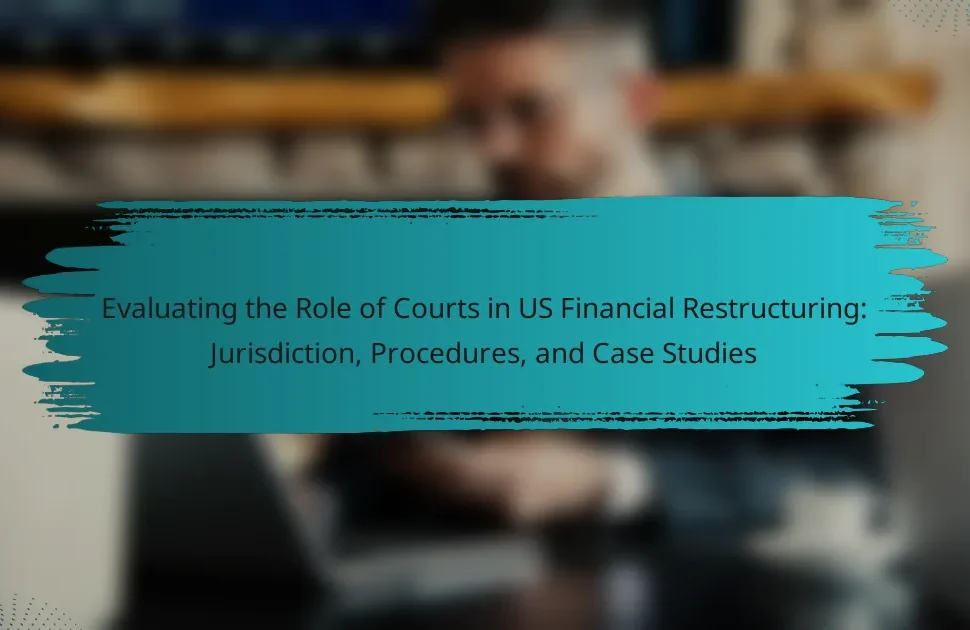Bankruptcy law in the United States provides a legal framework for individuals and businesses to reorganize or eliminate their debts through federal statutes, primarily the Bankruptcy Code. This law includes various chapters, such as Chapter 7 for liquidation and Chapter 11 for reorganization, allowing debtors to seek relief from creditors while ensuring fair treatment for all parties involved. Key legal implications include the automatic stay, which halts collection actions upon filing, and the potential long-term effects on credit ratings and access to future credit. The article will explore the types, procedures, and legal consequences of bankruptcy law, as well as available resources for further understanding.
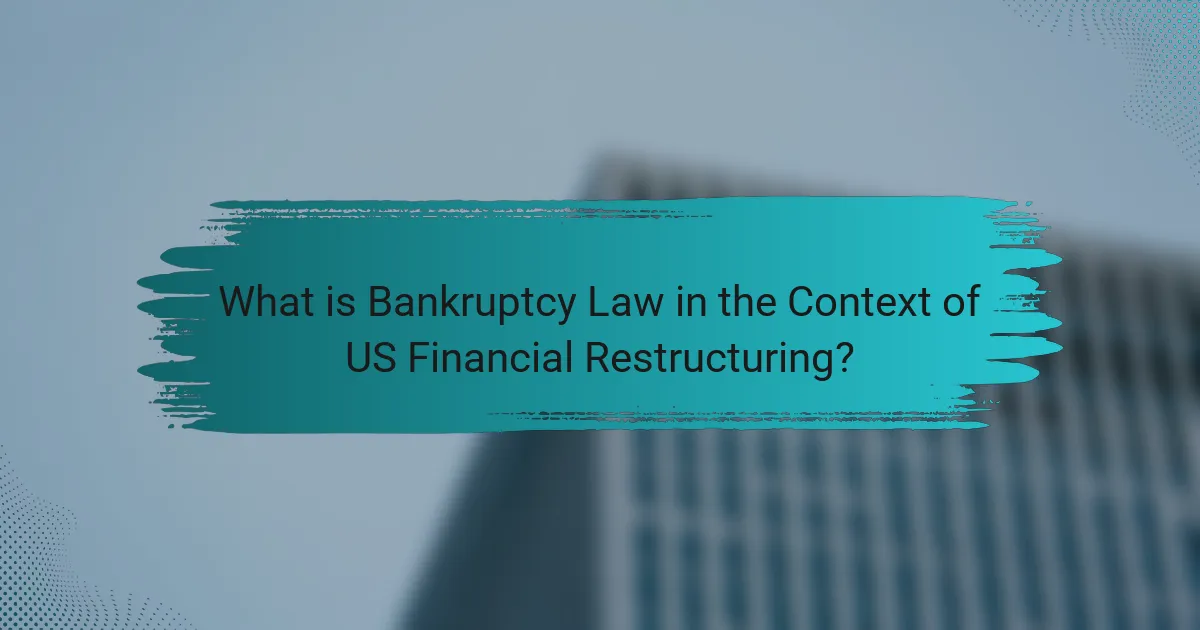
What is Bankruptcy Law in the Context of US Financial Restructuring?
Bankruptcy law in the context of US financial restructuring refers to the legal framework governing the process by which individuals or businesses can reorganize or eliminate their debts. This law provides a mechanism for debtors to seek relief from creditors while ensuring fair treatment of all parties involved. It primarily operates under federal statutes, particularly the Bankruptcy Code. The law encompasses various chapters, such as Chapter 7 for liquidation and Chapter 11 for reorganization. These provisions allow for the restructuring of debts and the preservation of business operations. Bankruptcy law aims to balance the interests of debtors seeking a fresh start with the rights of creditors to recover owed amounts. The law has evolved through historical cases and legislative amendments, reflecting changes in economic conditions and societal values.
How does Bankruptcy Law function within the US legal system?
Bankruptcy law in the US legal system provides a legal framework for individuals and businesses to address insolvency. It allows debtors to eliminate or restructure their debts under the protection of the federal bankruptcy court. The primary statutes governing bankruptcy are found in Title 11 of the United States Code. There are several types of bankruptcy filings, including Chapter 7, Chapter 11, and Chapter 13. Chapter 7 allows for liquidation of non-exempt assets to repay creditors. Chapter 11 enables businesses to reorganize and continue operations while repaying debts. Chapter 13 provides individuals a repayment plan to pay off debts over three to five years. The process begins with filing a petition in bankruptcy court, which triggers an automatic stay to halt collection actions. Creditors are then notified and can file claims against the bankruptcy estate. The court oversees the proceedings, ensuring compliance with legal requirements. This system aims to balance the interests of debtors seeking relief and creditors seeking repayment.
What are the key principles underlying Bankruptcy Law?
The key principles underlying Bankruptcy Law include the equitable distribution of assets, the discharge of debts, and the protection of creditors’ rights. Equitable distribution ensures that all creditors receive fair treatment during the bankruptcy process. The discharge of debts allows individuals or businesses to eliminate certain obligations, providing a fresh start. Protection of creditors’ rights is essential, as it maintains the balance between debtors and creditors. Additionally, the principle of good faith requires debtors to act honestly in the bankruptcy process. These principles are designed to create a fair and orderly resolution of financial distress.
How does Bankruptcy Law differ from other areas of law?
Bankruptcy law differs from other areas of law primarily in its focus on financial distress and debt relief. It provides a legal framework for individuals and businesses to reorganize or eliminate debts. Unlike criminal law, which addresses offenses against the state, bankruptcy law is civil in nature. It aims to balance the interests of debtors and creditors. Bankruptcy proceedings can involve liquidation or reorganization, distinct from typical contract law disputes. The process is governed by federal statutes, specifically the Bankruptcy Code. This uniformity contrasts with other areas of law that may vary by state. Bankruptcy law also includes specific protections for debtors, such as exemptions for essential assets. These characteristics highlight its unique role in the legal system.
What are the main types of Bankruptcy in the US?
The main types of bankruptcy in the US are Chapter 7, Chapter 11, and Chapter 13. Chapter 7 bankruptcy involves liquidation of assets to pay creditors. It is often referred to as “straight bankruptcy.” Individuals and businesses can file for Chapter 7. Chapter 11 bankruptcy is primarily for businesses seeking to reorganize debts while continuing operations. It allows for a restructuring plan to be formulated. Chapter 13 bankruptcy is available for individuals with a regular income. It enables them to create a repayment plan to pay back debts over three to five years. Each type serves different financial situations and needs.
What is Chapter 7 Bankruptcy and how does it operate?
Chapter 7 Bankruptcy is a legal process that allows individuals or businesses to eliminate most of their debts. It operates by liquidating non-exempt assets to pay creditors. Individuals must qualify based on income and pass a means test. Once approved, the court appoints a trustee to oversee the case. The trustee sells non-exempt assets and distributes the proceeds to creditors. Most unsecured debts, such as credit card debt, are discharged. This process typically takes three to six months to complete. In 2021, approximately 290,000 Chapter 7 cases were filed in the U.S., highlighting its common use for debt relief.
What is Chapter 11 Bankruptcy and what are its unique features?
Chapter 11 Bankruptcy is a legal process that allows businesses to reorganize their debts while continuing operations. It provides a framework for companies to restructure their financial obligations and maintain control over their assets. Unique features of Chapter 11 include the ability to propose a reorganization plan to creditors, the option to reject or assume contracts, and the automatic stay that halts collection actions against the debtor. Additionally, it allows for the possibility of converting to a Chapter 7 liquidation if reorganization fails. The process is overseen by a bankruptcy court, ensuring compliance with legal standards.
What is Chapter 13 Bankruptcy and who can benefit from it?
Chapter 13 Bankruptcy is a legal process allowing individuals to reorganize their debts. It is designed for individuals with a regular income who wish to repay their debts over time. This type of bankruptcy enables debtors to keep their property while making payments according to a court-approved plan. Individuals who can benefit from Chapter 13 typically include those with unsecured debts below $419,275 and secured debts below $1,257,850. This process can help individuals avoid foreclosure and repossession of assets. Additionally, it can provide a manageable repayment plan that lasts three to five years. Chapter 13 Bankruptcy is particularly beneficial for those who have fallen behind on mortgage or car payments but want to retain their assets.
What procedures are involved in filing for Bankruptcy?
Filing for bankruptcy involves several key procedures. First, individuals must complete credit counseling from an approved agency. This must be done within six months before filing. Next, they need to gather financial documents. This includes income statements, tax returns, and a list of debts and assets.
After preparing the necessary documents, the debtor must file a petition with the bankruptcy court. This petition includes detailed financial information and the type of bankruptcy being filed. Once filed, an automatic stay is issued. This halts most collection actions against the debtor.
The court will then appoint a trustee to oversee the case. The trustee reviews the petition and may require a meeting with creditors. This meeting allows creditors to ask questions about the debtor’s finances. Finally, after the process is complete, the court will issue a discharge of debts if applicable. This legal process can take several months to complete.
What are the steps to initiate a Bankruptcy filing?
To initiate a bankruptcy filing, start by determining the appropriate type of bankruptcy. Individuals typically file for Chapter 7 or Chapter 13. Next, gather all financial documents, including income statements, debts, and assets. After that, complete the required bankruptcy forms. These forms include the petition, schedules, and statement of financial affairs.
Once the forms are ready, file them with the bankruptcy court in your jurisdiction. Pay the associated filing fee or request a fee waiver if eligible. Attend the mandatory credit counseling session within 180 days before filing. Finally, after filing, notify creditors and attend the 341 meeting of creditors. This meeting allows creditors to ask questions regarding your financial situation.
How does the court process work during a Bankruptcy case?
The court process during a bankruptcy case involves several key steps. Initially, a debtor files a petition with the bankruptcy court. This petition includes detailed financial information. The court then schedules a meeting of creditors. This meeting allows creditors to question the debtor under oath. The court also appoints a trustee to oversee the case. The trustee manages the debtor’s assets and ensures fair distribution to creditors. After reviewing the case, the court may discharge certain debts. This discharge releases the debtor from personal liability for specific debts. The entire process typically takes several months to complete.
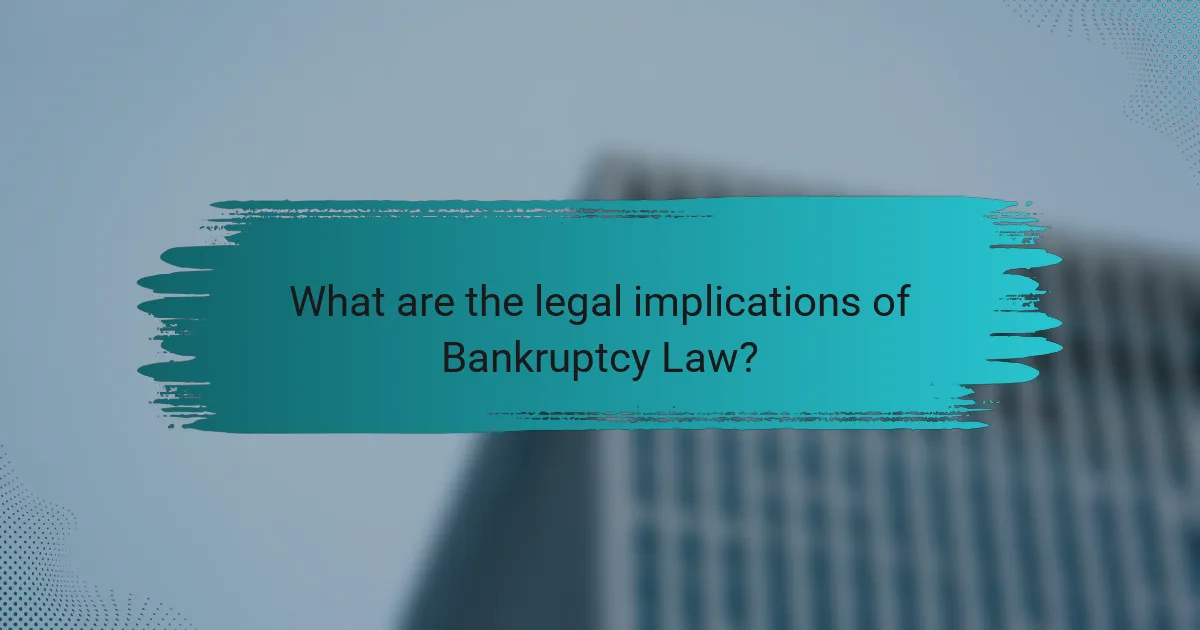
What are the legal implications of Bankruptcy Law?
Bankruptcy Law has significant legal implications for individuals and businesses. It provides a legal framework for debt relief and financial restructuring. Under this law, debtors can eliminate or repay their debts under the protection of the bankruptcy court. This process can lead to the discharge of certain debts, providing a fresh financial start.
However, filing for bankruptcy can also have long-term effects on credit ratings and access to future credit. It may affect the debtor’s ability to obtain loans or mortgages. Additionally, bankruptcy can impact business operations, as it may involve liquidation of assets.
Legal implications also include the automatic stay, which halts collection actions against the debtor upon filing. This protection allows debtors time to reorganize their finances without harassment from creditors. Bankruptcy Law is governed by federal statutes, ensuring uniformity across states.
In summary, Bankruptcy Law offers relief while imposing consequences on credit and financial opportunities.
How does Bankruptcy affect creditors and debtors?
Bankruptcy significantly impacts both creditors and debtors. For debtors, bankruptcy provides relief from overwhelming debts. It allows for a fresh start by discharging certain liabilities. Debtors may also gain protection from creditors through an automatic stay. This prevents creditors from pursuing collection efforts during the bankruptcy process.
For creditors, bankruptcy can lead to reduced recovery of owed amounts. They may receive only a portion of what they are owed or nothing at all. The priority of claims determines how much creditors recover. Secured creditors usually have a higher priority than unsecured creditors. Additionally, bankruptcy can alter the terms of existing debts. It may restructure payment plans or reduce total debt amounts.
In summary, bankruptcy serves as a legal mechanism that reshapes the financial landscape for both creditors and debtors.
What rights do creditors have in a Bankruptcy proceeding?
Creditors have specific rights in a bankruptcy proceeding. They can file claims to recover debts owed to them. Creditors are entitled to receive notice of the bankruptcy filing. They can participate in creditors’ meetings to discuss the debtor’s financial situation. Creditors have the right to vote on bankruptcy plans that affect their claims. Secured creditors have priority over unsecured creditors in asset distribution. They can also challenge the discharge of certain debts under specific circumstances. These rights are outlined in the Bankruptcy Code, which governs bankruptcy proceedings in the United States.
What protections are offered to debtors under Bankruptcy Law?
Bankruptcy Law offers several protections to debtors. These protections include an automatic stay, which halts all collection activities once a bankruptcy petition is filed. Debtors are shielded from wage garnishments, foreclosure proceedings, and repossession of property during this period. Additionally, bankruptcy can lead to the discharge of unsecured debts, relieving debtors of the obligation to pay certain obligations. Debtors may also retain essential property under exemptions provided by state or federal law. Furthermore, bankruptcy law allows for a structured repayment plan, enabling debtors to manage their debts more effectively. These protections are designed to provide a fresh start for individuals facing financial difficulties.
What are the long-term consequences of filing for Bankruptcy?
Filing for bankruptcy has significant long-term consequences. One major consequence is a lasting impact on credit scores. A bankruptcy can remain on a credit report for up to 10 years. This can hinder future borrowing opportunities. Individuals may face higher interest rates on loans. Additionally, securing rental housing may become more difficult. Employers may also conduct credit checks during hiring processes. This can affect job prospects in certain industries. Overall, bankruptcy can limit financial options for many years.
How does Bankruptcy impact credit scores and future borrowing?
Bankruptcy significantly lowers credit scores. This drop can range from 130 to 240 points, depending on the individual’s credit history. A bankruptcy filing remains on credit reports for seven to ten years. This long-term presence negatively affects future borrowing opportunities. Lenders often view bankruptcy as a sign of high risk. Consequently, individuals may face higher interest rates on loans. Some lenders may deny credit applications altogether. Over time, responsible financial behavior can help rebuild credit scores.
What are the potential tax implications of Bankruptcy?
Bankruptcy can have significant tax implications. Discharged debts in bankruptcy may not be taxable. However, if debts are forgiven, the IRS may consider this as income. This can lead to a tax liability for the debtor. Additionally, certain bankruptcy filings can affect tax refunds. For instance, a debtor may lose their tax refund to pay creditors. It’s essential to understand these implications before filing. Consulting a tax professional is advisable for personalized guidance.
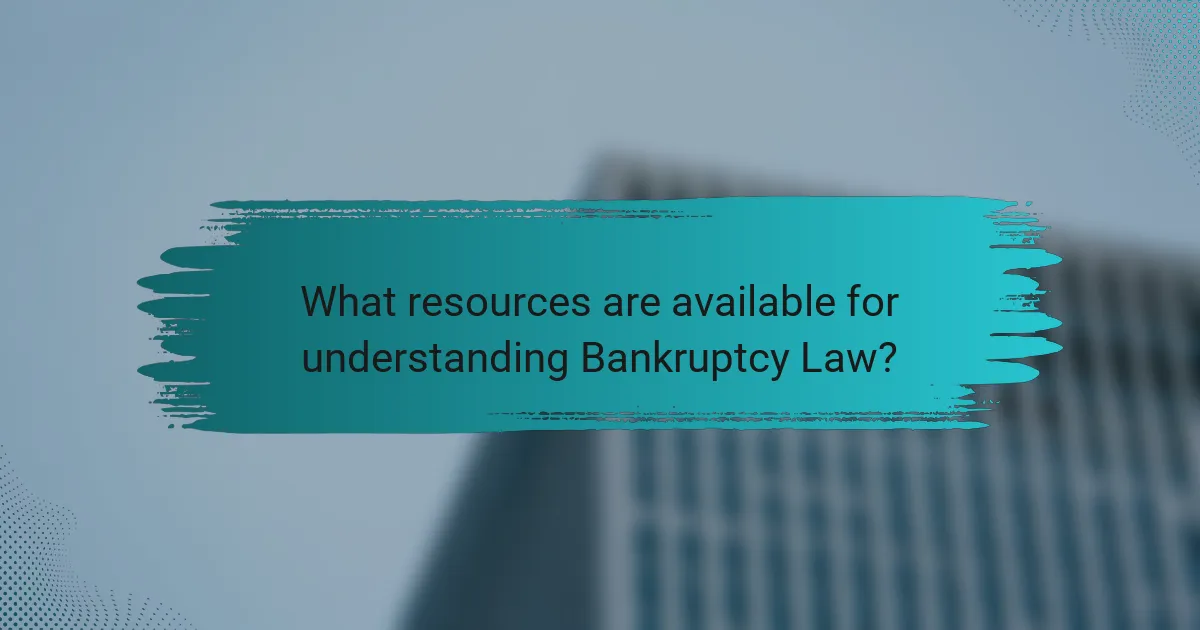
What resources are available for understanding Bankruptcy Law?
Legal textbooks provide comprehensive insights into Bankruptcy Law. Notable titles include “Bankruptcy and Debtor/Creditor” by David G. Epstein. Online legal databases like Westlaw and LexisNexis offer case law and statutes. The U.S. Courts website presents official information on bankruptcy procedures. Law school libraries often contain specialized resources on the subject. Additionally, nonprofit organizations like the American Bankruptcy Institute provide educational materials. These resources are widely used by legal professionals and students alike.
How can individuals seek legal advice regarding Bankruptcy?
Individuals can seek legal advice regarding bankruptcy by consulting a bankruptcy attorney. Bankruptcy attorneys specialize in the legal aspects of bankruptcy law. They can provide guidance on the types of bankruptcy available, such as Chapter 7 and Chapter 13. Individuals can find qualified attorneys through local bar associations or legal aid organizations. Online directories also list bankruptcy lawyers with reviews and ratings. Initial consultations are often free, allowing individuals to assess their options. Many attorneys offer flexible payment plans for their services. Seeking legal advice is crucial to navigate the complexities of bankruptcy effectively.
What are some reputable organizations that provide information on Bankruptcy?
The American Bankruptcy Institute (ABI) is a leading organization providing information on bankruptcy. ABI offers resources, educational programs, and research on bankruptcy law. The National Association of Consumer Bankruptcy Attorneys (NACBA) also provides valuable information and advocacy for consumer bankruptcy issues. The U.S. Courts website contains official information about bankruptcy procedures and forms. Additionally, the Federal Trade Commission (FTC) offers consumer information related to bankruptcy and credit issues. These organizations are recognized for their expertise and reliability in the field of bankruptcy.
How can online resources aid in understanding Bankruptcy Law?
Online resources significantly aid in understanding Bankruptcy Law by providing accessible information and educational tools. Websites like the U.S. Courts offer detailed explanations of different bankruptcy types, such as Chapter 7 and Chapter 13. Legal blogs and forums allow users to ask questions and engage with experts in real-time. Online courses and webinars provide structured learning experiences, often featuring legal professionals as instructors. Additionally, many resources include case studies that illustrate the application of bankruptcy laws in real scenarios. These resources enhance comprehension through visual aids, such as infographics and videos, simplifying complex legal concepts. By utilizing these online tools, individuals can gain a clearer understanding of their rights and options under Bankruptcy Law.
What best practices should individuals follow when considering Bankruptcy?
Individuals considering bankruptcy should first assess their financial situation thoroughly. This includes reviewing debts, income, and assets. They should explore alternatives to bankruptcy, such as debt counseling or negotiation. Consulting with a bankruptcy attorney is crucial for understanding legal options and implications. Individuals must gather necessary documentation, including tax returns and financial statements. They should also be aware of the types of bankruptcy available, such as Chapter 7 and Chapter 13. Understanding the impact on credit scores is essential, as bankruptcy can significantly affect creditworthiness. Finally, individuals should prepare for the post-bankruptcy period by establishing a budget and rebuilding credit.
Bankruptcy Law is the legal framework governing the process of debt reorganization or elimination for individuals and businesses in the U.S. This article provides an overview of the types of bankruptcy, including Chapter 7, Chapter 11, and Chapter 13, as well as the procedures involved in filing for bankruptcy. Key principles such as equitable distribution of assets, discharge of debts, and creditor protections are examined, along with the legal implications for both debtors and creditors. Additionally, the article discusses the long-term consequences of bankruptcy, available resources for understanding the law, and best practices for individuals considering bankruptcy.
